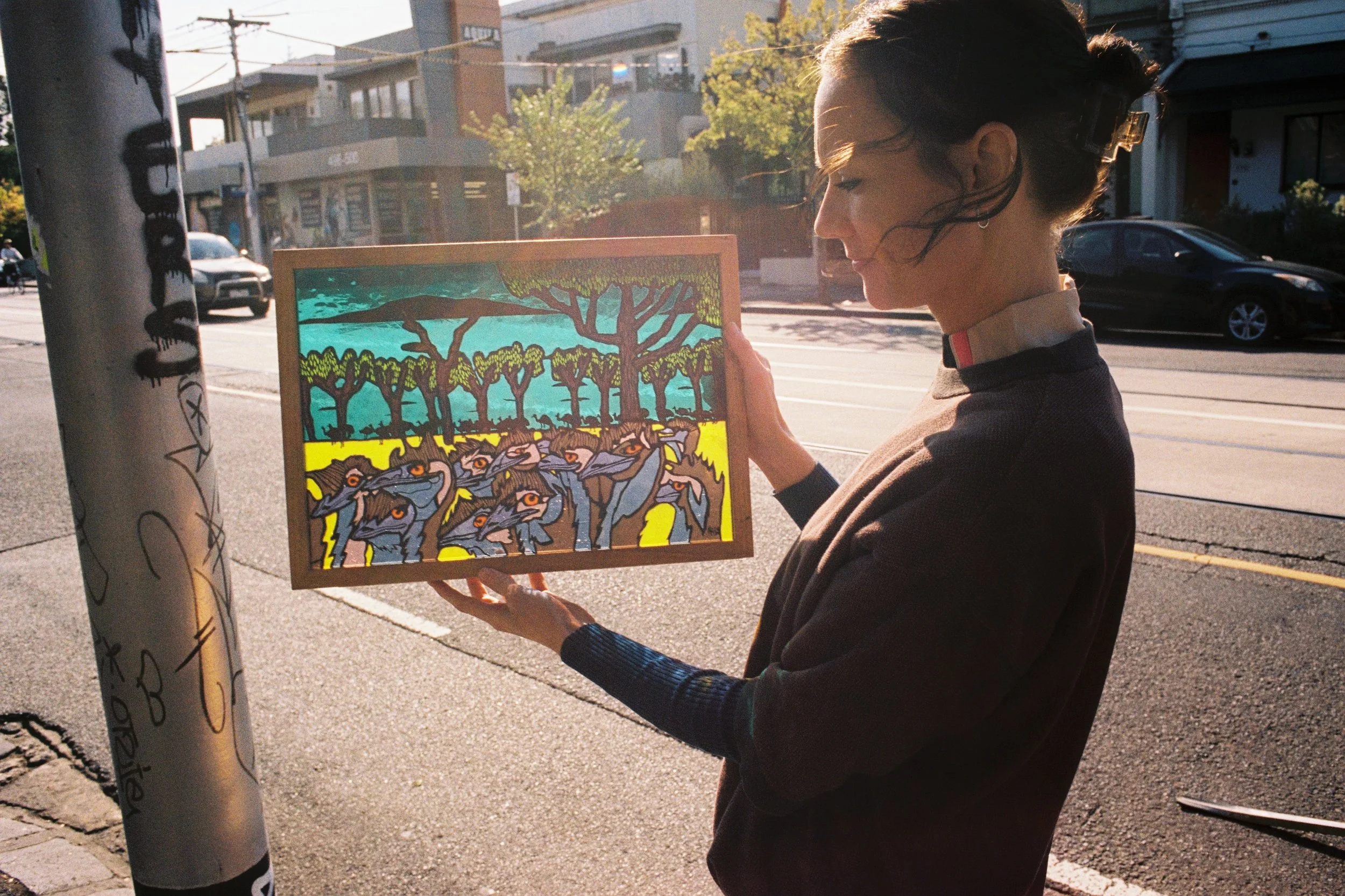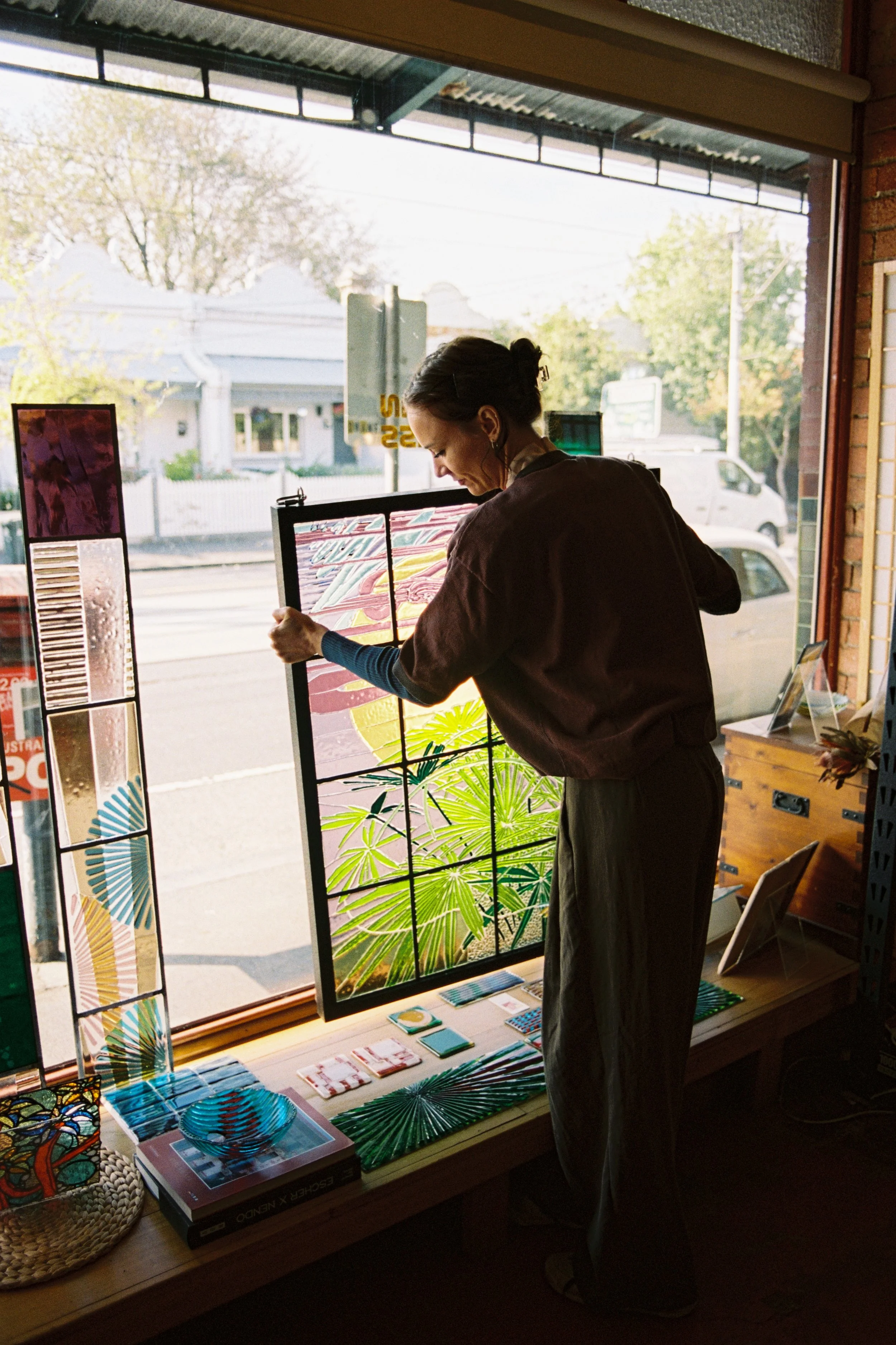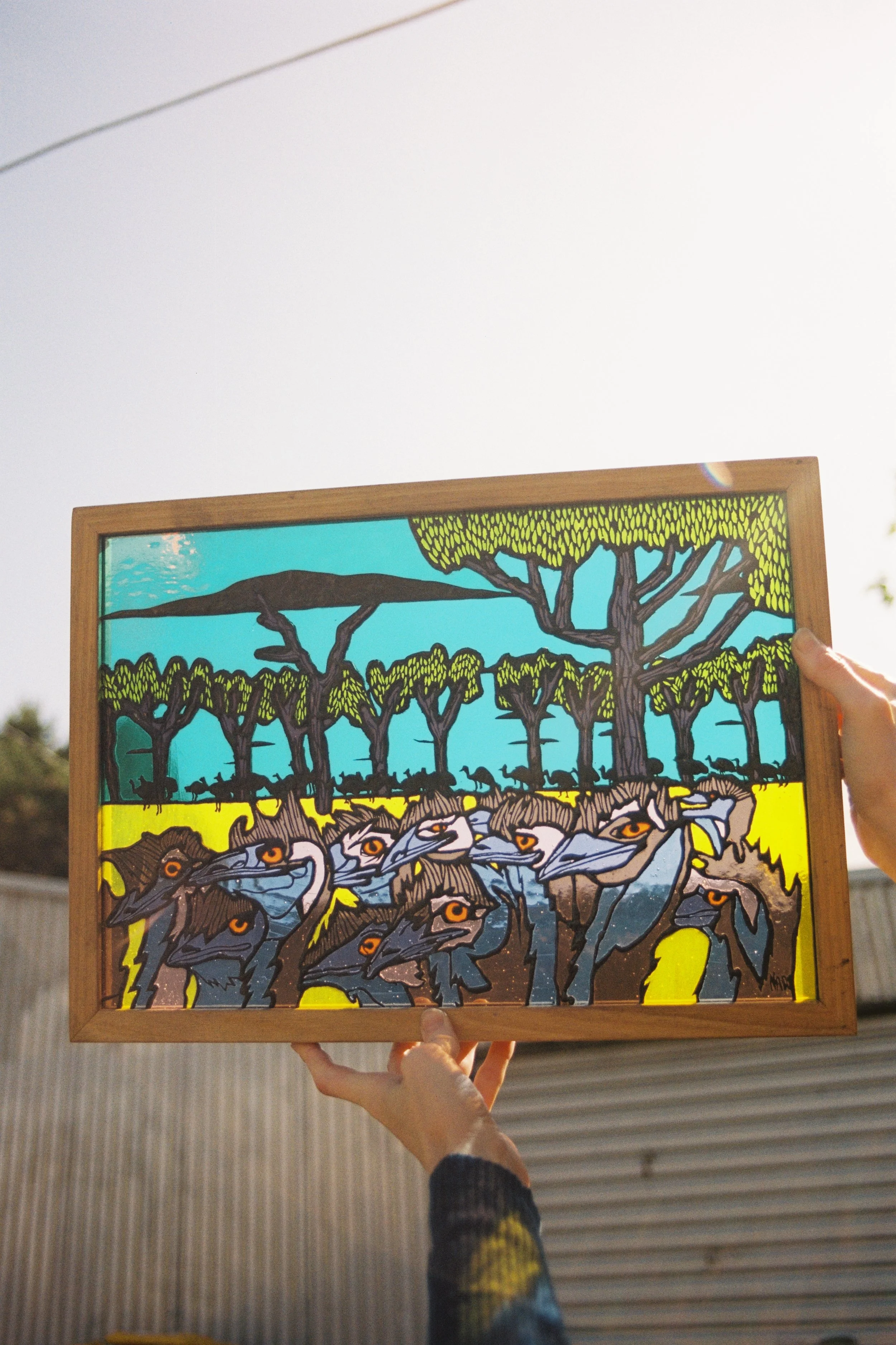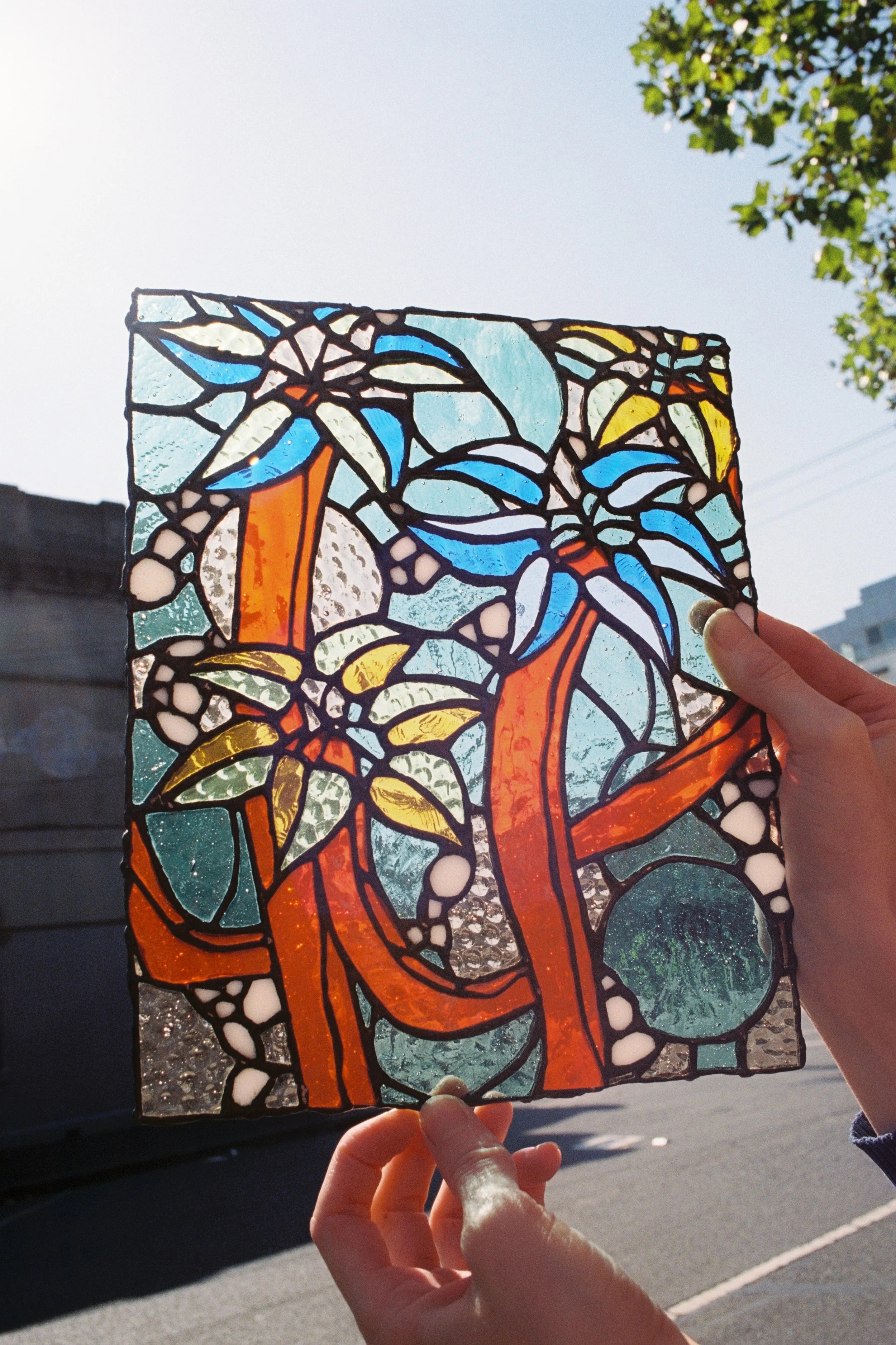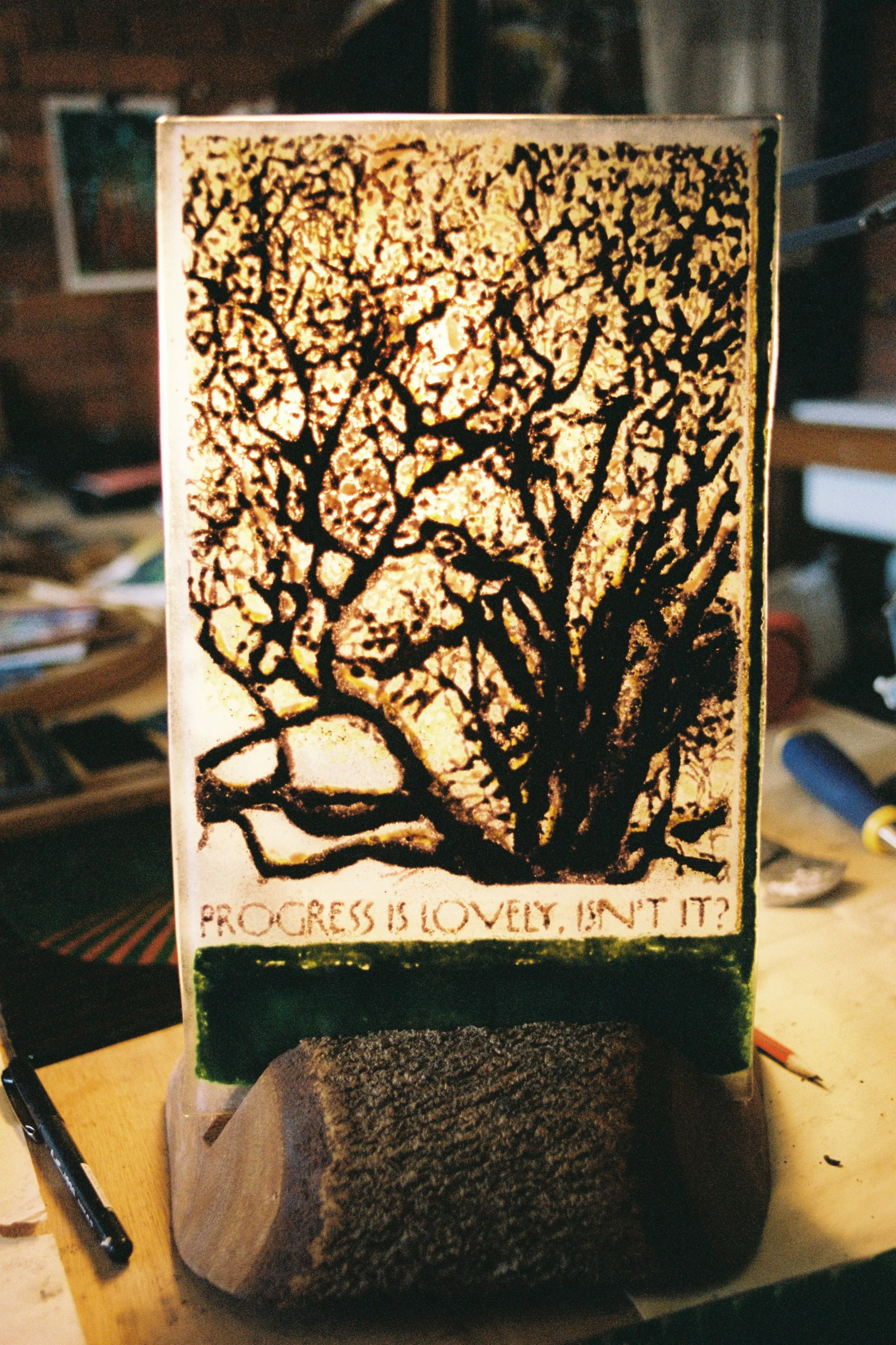An Artist You Should Know: Nadine Keegan
Photography by Josh Sabini.
My first memorable experience with stained glass was at the National Gallery of Victoria on an excursion with my year one class.
I was enamoured looking up at Leonard French’s stained glass ceiling which happens to be the largest in the world. It was unlike anything I had ever seen, the shapes, the colours, the way the light shined through, I spent the next half an hour lying on my back looking up, admiring it. Walking past Nadine Keegan’s showroom in Melbourne’s inner north suburb of Fitzroy, I discovered her work, looking through the window revoked that feeling I got as a six year old looking up at the ceiling; I was in awe. Inspired by life, contemporary art and so much more, Nadine’s work is unique, eye-catching and detailed in a way that to the everyday person seems nearly impossible. I reached out to Nadine to talk about her work and how she got acquainted with the divine medium.
I’d love to start by asking where the inspiration for you to make stained glass work came from?
I always wanted to be a craftsperson and really liked architecture. While I was on a trip through North America, I found out about Arts and Crafts architecture and realised it was the perfect combination of those two interests. When I went deeper into it and saw all the cool leadlights, I realised stained glass was the medium I wanted to work with.
Where were you when you found out about Arts and Crafts architecture?
I was in Mexico City, on a Solarpunk blog and it said, “If there was a real-world headquarters of Solarpunk it would be this place.” It was an hour away from where I was at a place called Cosmovitral en Toluca, so I went there the next day. It was a huge stained glass mural that was sort of esoteric and played on the concept of light and dark, seeing that building made me think about what was possible with stained glass in a new way beyond the classical religious work I grew up seeing.
What is Solarpunk?
Solarpunk is a utopian speculative fiction, which is the opposite of Cyberpunk which is dystopian.
Was it instant that after seeing it you decided that stained glass was something you wanted to do?
Yeah, it was instant. I had already kind of fallen in love with it but then when I saw that, I knew I had to.
When was that trip?
It was in 2017. I was 27 and looking for something new to start doing and thankfully found it. When I got home, I called every stained glass studio I could find until someone could give me a job.
Did you have much of a background in art before finding stained glass?
I did photography but I stopped doing art for a long time until I started doing stained glass work.
As you mentioned earlier, when most people think of stained glass their minds go straight to religious work in churches and places of worship. How does it feel to be able to challenge that idea by making the work you are?
I’m still doing something similar to the religious thing, but it isn’t directed to the same god [laughs]. I don’t exactly know what I’m trying to search for, but it’s in line with that. There’s a lot of secular stained glass but in the mediums of light and glass there is something divine about it, so you can’t help but think about something spiritual when you work with it.
I’m inspired by contemporary art, but I’m also very inspired by ancient civilisation’s architecture and artefacts. They were using glass too, so it’s a way of connecting yourself to modern humans doing something more primal.
What is it like working with a medium as old as stained glass but being able to incorporate new methods and technology into it?
It is super cool. You feel you are a part of a legacy; you feel like you have ancestors in it. It is also a natural material so there is a connection to nature. I love exploring and not knowing what something is going to look like so being able to manipulate my work in the way that modern kilns can do is really enjoyable. You get crazy results if you put something in the kiln and just try something because you’ve never seen it before.
Earlier we spoke about how you are taking influence from so many things, including famous artworks and literature. Do you feel like there is a limit on what you can do design wise?
I think about this a lot, my core interest groups change so rapidly that there is no way I could ever go to the end of it. You can go inwards into the material and the material inspires you. I follow my interests. There is a commonality between all of them, I am super curious about everything like ideas, people, outer space, the list goes on.
You’ve been starting to incorporate text into your stained glass in a way I haven’t seen before. When did you realise that was possible?
That still is stained glass but what I am really doing with that is using the materials in a way that deconstructs them. I love Vienna Secession text. I love good text and graphics, so it felt natural for me to try that. I am looking at so many things for inspiration and just want to try creating as many things as possible in glass.
Would you ever incorporate other mediums into your glasswork?
Yeah, at the moment I really love textiles, I’m really inspired by that, and want to do that in glass. I also want to translate that back to patchwork. I also want to use natural glass, like obsidian in some way. I kind of see myself in a way as a light artist, so I really like James Turrell and Olafur Eliasson, so following that idea that it’s about light and atmosphere in spaces more than just the image of the artwork itself.
Yeah, even going back to the deconstructed stained glass pieces, do you feel like you are trying to do things with the medium that you haven’t seen?
Yeah, what I’m doing is using fused glass, which was developed in ancient Egypt. I was obsessed with ancient Egypt as a kid and that comes up so much here. I just want to do things I haven’t seen before, I get bored really quickly so the unknown is the most exciting area.
I think that’s great especially because it’s a medium with so many limitations of what you can do.
In comparison to what is possible, nothing has been done. There is a big community of people who want to keep it traditional. I love and respect that, because it is important to keep the traditional practice of something so old, however, I love expanding on tradition more. As an artist I think you need to have a rebellious spirit and limiting that really blocks what is possible to create. I don’t want to be trapped by it and I haven’t felt like I have been.
On your website, you wrote when you found stained glass you discovered the creative industry which aligned with your ideals. What are those ideals?
There are so many things from the politics to the actual act of creating. I love countercultures and speculative fictions that envision alternative futures. Arts and Crafts were an anti-industrialisation movement, so questioning the manufacturing process and role of beauty in products that were incorporated into and changed environments was big for me. There are so many elements, I can build worlds or at least help create nice spaces and do it in a way that is ethical and fun to make. Then being able to create a tangible piece from something you thought about is incredible.
What’s next for you from here?
I have lofty goals, but I think it comes down to wanting to continually expand what’s possible in the medium and myself. I would like to make an Australian version of Cosmovitral [laughs]. I’ve kind of learnt to work hard but go with the flow so I’m excited to see where that ends up.

